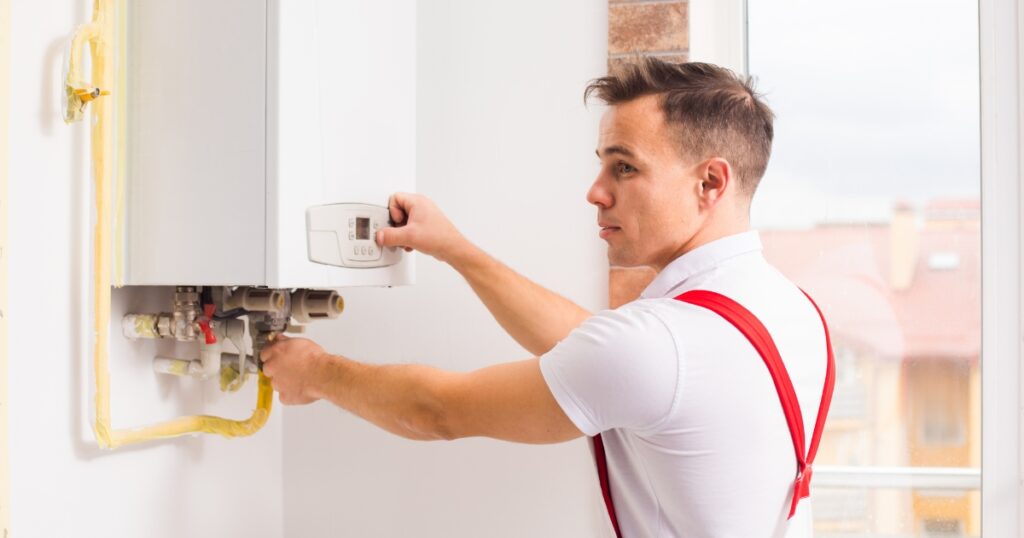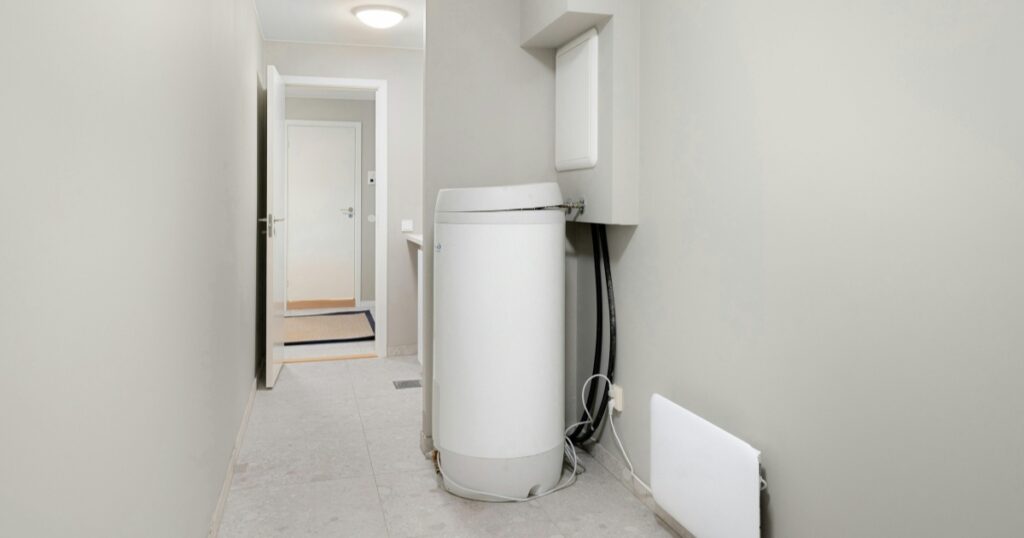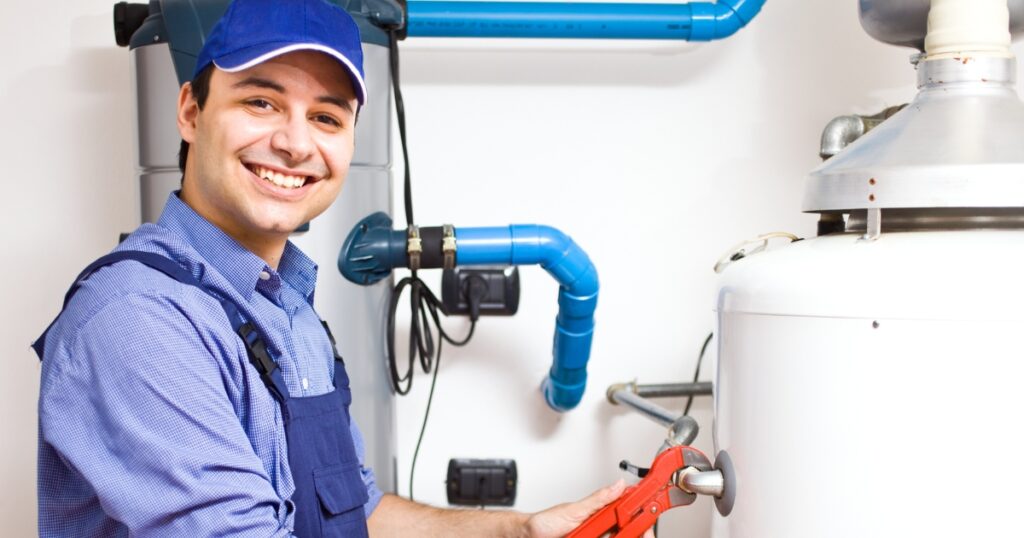Ever had a blinder of a hot shower suddenly go cold on ya? It’s a rotten experience we’ve all copped at some point, and not just because it jolts you out of your peaceful sudsing. Unexpected shifts in water temperature can also carry potential health risks – enough to even make the bravest Aussie battler wince.
So, what’s going on here? Our detailed chinwag with experts reveals that dodgy equipment lurking in your home’s hot water system is usually the main culprit behind these ripples in your bath time peace.
In this article, we’ll debrief you about the underlying causes, share some dinky-di DIY fixes for smaller hitches and guide you on when it might be time to call in the tradies for professional help.
Ready to crack onto those solutions? Righto, let’s get stuck into it!
Key Takeaways
- Inconsistent hot water temperature can be caused by faulty mixer valves, dip tubes, on – demand water heaters, or mineral buildup.
- DIY solutions like replacing parts and descaling your water heater can help resolve the issue in some cases.
- Professional help should be sought if there are serious issues, safety concerns, or warranty coverage.
- Regular maintenance and inspections are essential for preventing future temperature inconsistencies and prolonging the lifespan of your water heater.
Understanding the Causes of Inconsistent Water Temperature
There are several possible causes for inconsistent hot water temperature, including a faulty mixer valve or cartridge, issues with the dip tube in the water heater, problems with on-demand water heaters, and mineral buildup or blockages.
Faulty mixer valve or cartridge
A faulty mixer valve or cartridge in your water heater can greatly disrupt the consistent flow of hot water in your home. This piece is integral to mixing cold and hot water to deliver the perfect shower temperature, but when it fails, the imbalance causes fluctuating temperatures.
You might experience a sudden burst of cold or scalding hot water. Replacing this can rectify inconsistent temperatures in many cases. For optimal functioning, immediate attention and action are necessary as soon as you become aware of an issue with the mixer valve or cartridge.
Faulty dip tube in water heater
If you’re experiencing inconsistent hot water temperatures in your showers or taps, a faulty dip tube in your water heater could be the culprit. The dip tube is responsible for directing cold water to the bottom of the tank so that it can be heated.
However, if the dip tube is broken or worn out, it can allow cold water to mix with hot water at the top of the tank, resulting in lukewarm or even cold water coming out of your faucets.
Replacing a faulty dip tube is a straightforward repair that can help restore consistent and comfortable hot water temperatures throughout your home.
Issues with on-demand water heaters
On-demand water heaters, also known as tankless water heaters, can present their own set of issues when it comes to inconsistent hot water temperature. One frequent problem is inadequate flow rate, which can cause fluctuations in temperature during high-demand periods.
Another issue may be related to the size of the unit itself – if you have a tankless heater that is too small for your needs, you may experience inconsistent temperatures. In some cases, mineral buildup or blockages within the system can also impact the performance of an on-demand water heater.
It’s important to address these issues promptly to ensure a steady supply of hot water in your home.
Mineral buildup or blockages
Mineral buildup or blockages in your water heater can lead to inconsistent water temperature. Over time, minerals like calcium and magnesium can accumulate in the heating elements or pipes, obstructing the flow of hot water.
This buildup restricts the efficiency of your water heater and can cause fluctuations in water temperature. To address this issue, it is important to regularly flush out and descale your water heater to remove any mineral deposits.
By doing so, you can ensure a more consistent supply of hot water for your everyday needs.
DIY Solutions for Addressing Inconsistent Water Temperature
If you’re experiencing inconsistent water temperature, there are simple DIY solutions that can help resolve the issue. From replacing faulty parts to descaling your water heater, we’ve got you covered.

Replacing mixer valve or cartridge
One effective solution for addressing inconsistent water temperature is replacing the mixer valve or cartridge in your shower. Over time, these components can become worn out or develop faults, leading to fluctuations in hot and cold water flow.
By replacing the faulty mixer valve or cartridge with a new one, you can restore consistent water temperature and ensure a more enjoyable showering experience. It is recommended to seek professional help for this task as it requires specific plumbing knowledge and skills.
Additionally, regularly maintaining and inspecting your water heater can help identify any issues with the mixer valve or cartridge early on and prevent further inconsistencies in the future.
Replacing dip tube in water heater
To address inconsistent hot water temperature in your water heater, one possible solution is to replace the dip tube. The dip tube is responsible for delivering cold water to the bottom of the tank, where it gets heated.
Over time, the dip tube can deteriorate or break, causing it to deliver cold water higher up in the tank instead of at the bottom. This can result in lukewarm or even cold water coming out of your faucets and showers.
By replacing the faulty dip tube with a new one, you can ensure that cold water is properly delivered to be heated and maintain consistent hot water temperatures throughout your home.
Descaling water heater
Regular descaling of your water heater is crucial to maintain consistent hot water temperature. Over time, mineral deposits can build up in the tank, which can affect the efficiency and performance of your heater.
By descaling your water heater, you remove these deposits and ensure that heat is transferred effectively to the water. This simple maintenance task can help prevent fluctuating temperatures and keep your showers comfortable and enjoyable.
Don’t forget to regularly schedule a descaling routine for your water heater to prolong its lifespan and avoid any potential issues with inconsistent hot water temperature.
Checking for blockages
To address inconsistent water temperature in your home, it’s important to check for blockages. Blockages can disrupt the flow of hot water and cause fluctuations in temperature. Start by examining the pipes leading to your water heater and look for any signs of mineral buildup or debris.
If you notice any blockages, it’s recommended to flush out the system or call a professional plumber to assist you. By ensuring that there are no obstructions in the pipes, you can help maintain a consistent and reliable supply of hot water throughout your home.
Regularly checking for blockages is an essential step in troubleshooting temperature inconsistencies with your water heater.
Adjusting water usage habits
We can contribute to resolving inconsistent water temperature issues by adjusting our water usage habits. One way is to spread out hot water usage throughout the day instead of using it all at once.
This allows the water heater enough time to recover and maintain a more consistent temperature. Additionally, being mindful of other appliances that use hot water simultaneously can help prevent temperature fluctuations.
For example, running the dishwasher or doing laundry while someone is in the shower may cause variations in water temperature. By making small changes in how we use hot water, we can improve its consistency and ensure a more enjoyable experience for everyone in the household.
When to Seek Professional Help
If you notice signs of serious issues with your hot water temperature, such as dangerous fluctuations or crossed connections, it’s time to seek the help of a professional plumber. Don’t risk safety concerns or voiding your warranty – let the experts handle it.
Read on to learn more about when professional help is necessary!
Signs of serious issues
If you notice any of these signs, it may indicate serious issues with your water heater. First, if you experience frequent and abrupt temperature changes in your showers or faucets, this could be a sign of a malfunctioning thermostat or heating element.
Second, if your hot water consistently comes out scalding or lukewarm despite adjusting the thermostat settings, there may be a problem with the tempering valve that requires immediate attention to prevent serious burns.
Lastly, if you are unable to get any hot water at all while cold water is still functioning properly, this could point to a larger issue with the water heater itself.
Safety concerns
We understand that safety is a top priority when it comes to your hot water system. Inconsistent water temperature can pose serious risks, such as the potential for dangerous water temperatures or even serious burns.
A faulty tempering valve, thermostat calibration issues, and improper water heater temperature settings can all contribute to these safety concerns. It’s essential to address these issues promptly to ensure the wellbeing of you and your family.
Regular maintenance and inspections are key in preventing future problems and prolonging the lifespan of your water heater.
Warranty coverage
If you’re experiencing issues with inconsistent hot water temperature and your water heater is still under warranty, it’s important to understand what is covered. Most warranties on water heaters typically cover defects in materials or workmanship for a specific period of time.
This means that if your water heater malfunctions due to a manufacturing defect, the cost of repairing or replacing the faulty parts may be covered by the warranty. However, it’s essential to read through the warranty terms and conditions carefully to determine what exactly is covered and any limitations or exclusions that may apply.
If you believe the inconsistent water temperature issue falls within the scope of your warranty coverage, contacting the manufacturer or a licensed professional can ensure that you receive appropriate assistance without incurring unnecessary costs.
Regular maintenance and inspections can help prolong the lifespan of your water heater and prevent future issues with inconsistent hot water temperature. Taking proactive steps such as flushing out sediment, inspecting heating elements, checking thermostat settings, and ensuring proper insulation can go a long way in maintaining optimal performance.
Additionally, understanding common causes of inconsistent temperatures like crossed connections or faulty tempering valves allows you to address these problems promptly before they worsen over time.

Importance of Regular Maintenance and Inspections
Regular maintenance and inspections are crucial in preventing future issues with inconsistent hot water temperature, prolonging the lifespan of your water heater, and ensuring safe and efficient operation.
Preventing future issues
To prevent future issues with inconsistent hot water temperature, it’s important to prioritise regular maintenance and inspections of your water heater.
By scheduling routine check-ups, you can identify any potential problems before they escalate into major issues. Additionally, make sure to follow proper maintenance guidelines provided by the manufacturer and have a professional plumber conduct regular servicing. Taking these proactive measures will help prolong the lifespan of your water heater and ensure that you continue to enjoy consistent hot water temperatures without any unexpected surprises.
Prolonging the lifespan of your water heater
Regular maintenance and inspections are key to prolonging the lifespan of your water heater. By scheduling regular maintenance, you can prevent future issues from arising and ensure that your water heater is working efficiently.
This includes flushing out any sediment or mineral buildup, checking for leaks or cracks, and calibrating the thermostat to ensure proper temperature control. Regular maintenance not only helps to extend the life of your water heater but also improves its overall performance, saving you money on repairs and replacement costs in the long run.
Don’t neglect this important step in maintaining a reliable hot water supply for your home.
Tips for Addressing Inconsistent Water Temperature in Repairs
To address inconsistent water temperature in repairs, it is crucial to identify the underlying causes. Whether it’s a faulty mixer valve or cartridge, mineral buildup in the water heater, or issues with on-demand systems, pinpointing the problem is key.
DIY solutions such as replacing faulty parts and descaling can help resolve the issue. However, if you notice signs of serious problems or safety concerns, it’s best to seek professional help.
Regular maintenance and inspections are also important for preventing future temperature inconsistencies and prolonging your water heater’s lifespan.






